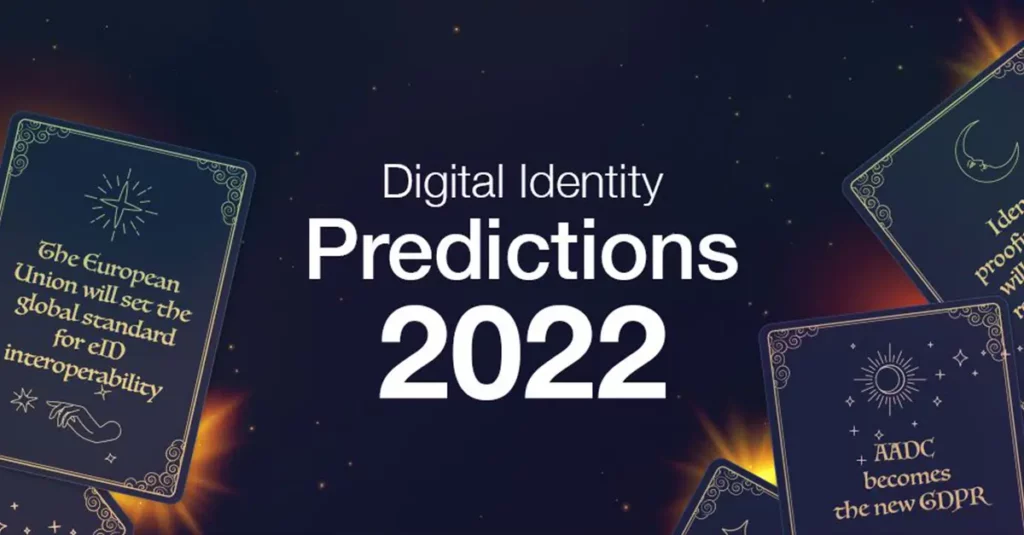
It is said that it’s difficult to make predictions, especially about the future. At the end of every year, we take a few minutes to reflect on what has happened and compare that to what we thought would happen. This time of reflection is vital in our line of work – after all, designing and implementing strategies in niche and fragmented markets like digital identity requires an ability to look up from the short term and the trivial to view the long term and the essential.
Beyond just our predictions last year, 2021 was a year with more ups than downs, a few radically unexpected events, and what feels like a collective agreement that everything needs to improve – that there is no time left to sit back and wait. We saw the market recognize the importance of digital identity, pumping over $25B in investment dollars into the space. A release valve for pent-up capital, the SPAC market boomed, busted, and has started to rally again. Bitcoin stalwarts institutionalized a brand change to decentralized finance (or DeFi for short), shifting the conversation away from who was using this technology to how this technology can be used to make transactions more efficient. We ended the year with Facebook’s announcement of Meta, a final signal that the metaverse is coming and Ready Player Two will need to become mandatory reading alongside 1984.
Here are our team’s top predictions for 2022
- Apple struggles to scale its digital driver’s license platform nationwide
While Apple announced its intention to launch its eID platform in 2021, we predict Apple will face difficulty in achieving its target of 50-state deployment in 2022. While Apple has embraced the ISO 18013-5 standard for mobile driver’s license (mDL) interoperability, their demands for full control over mDL program rollout and marketing materials will not be an easy sell in statehouses across the nation.
- The European Union will set the global standard for eID interoperability
The passage of a finalized eIDAS 2.0 standard by the European Commission will place the European Union at the forefront of the global push for governments to offer their citizens electronically-native identity credentials. While only pilot programs are likely to kick off in 2022, this will ignite conversations across the globe on the role eID is set to play in the next decade.
- Identity proofing players will become as recognizable to consumers as Plaid
Vendors like Jumio, Onfido, and Persona will extend their product to become the preferred identity vendor to verify and authenticate users throughout the customer journey. These additional capabilities will help put these vendors in front of consumers as they follow a pathway similar to Plaid.
- AADC becomes the new GDPR
In September, the UK’s ICO passed the Age Appropriate Design Code (AADC) or Children’s Code, which poses stricter compliance requirements for not only services aimed at children, but those likely to be used by them. Although the likes of TikTok, Facebook, and YouTube have already started implementing new privacy preserving practices, we anticipate online safety will have a larger ripple effect, and businesses that once relied on check-the-box age gates will grapple with stepping-up age assurance requirements without violating user privacy - The race to be a major consumer digital identity brand will heat up
With the NortonLifeLock and Avast merger still yet to close and fresh on everyone’s mind, consumer identity brands like Experian, Allstate Identity, and ID.me will push even harder to capture market share. New companies building decentralized identity platforms will gain adoption and become key targets for acquisition or real competition to these incumbents.
In addition to selecting a few of our best predictions, we thought it would be fun to share our internal list of solution solutions and startups to watch in 2022. We are even dropping a few hints about some of the changes to the landscape for 2022.
Solution segments we are keeping our eye on in 2022
- Credit & Financial Identity
We are shifting away from the term “alt credit” in 2022 and recognizing that solution providers must leverage alternative methods alongside traditional credit scoring to provide a complete picture of an individual’s financial identity. With credit decisioning and analytics making its way to P0 status on many of your favorite digital identity companies’ product roadmaps, we expect to see a rush of new products, services, companies, and technologies emerge in this segment.
- eIDs, Civil IDs, and Identity Networks
A new segment to our landscape in 2022, eIDs, Civil IDs, and Identity Networks represent a grouping of solutions that will likely be broken up in future iterations of the landscape as products mature and companies begin to differentiate themselves. It should be no surprise that we are following this new segment closely, given all of our recent research on consumer digital identity (Consumer Digital Identity Landscape, The Life of PIEs, GAIN Digital Trust). We expect to see public sector adoption and private sector investment equalize, which in turn can unlock the holy grail of digital identity – reusable identity credentials.
- Identity Graphing & Resolution
A segment that gets little love from the market these days, Identity Graphing & Resolution is primed for a rally. Unlike the martech companies using third-party cookies to build identity graphs for ad placement, companies developing innovative techniques to accomplish the same goals but in a privacy-preserving way are set to unlock tremendous value.
- Business & Entity Verification
Last year we split KYC and KYB (now just referenced here as Business & Entity Verification). We rationalized the split by analyzing the market trends and finding startups like Middesk and Sayari are approaching the KYB and UBO problem in a radically different way than their KYC counterparts. Instead of just connecting to government databases, they are actively redesigning the industry classification codes, establishing ownership networks, and creating an entirely new (and better) infrastructure layer to build upon. In 2022, we see this “infrastructure” paying dividends, especially as regulators push financial and non-financial companies harder on knowing who they are doing business with.

